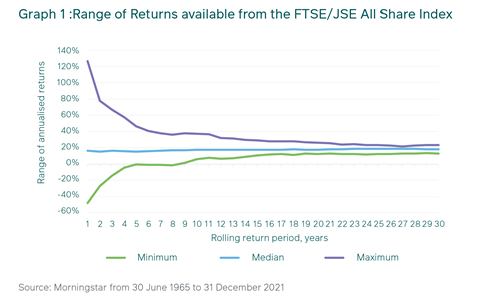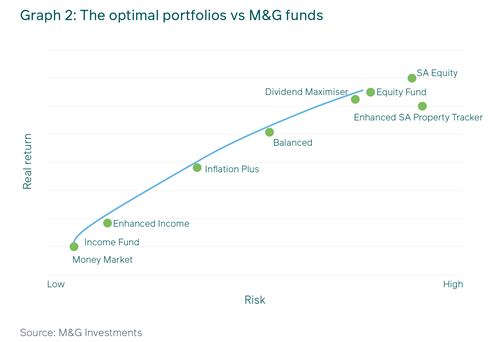TABLE TALK: How to position your portfolio to mitigate the impact of rising inflation and market volatility
This article was first published in the Quarter 1 2022 edition of Consider this. Click here to download the complete edition.
Question
I’m concerned about the impact of rising inflation and also market volatility from the Russia-Ukraine war on my longer-term investments. How should I position my portfolio to mitigate these risks?
Answer
A good starting point is to ensure your long-term investment portfolio is correctly structured to be able to meet your investment objectives over the long term. This would include ensuring that it has adequate exposure to risk assets (such as equities), which is also one of the best ways to protect your investment portfolio against rising inflation. Making sure your portfolio is appropriately diversified is also important – diversification is one of the most powerful tools available to investors. It provides a number of advantages, including mitigation of portfolio downside (drawdown risk) in volatile conditions like the present.
Sufficient exposure to risk assets
Many South African investors have been de-risking their portfolios over the last five years or so due to the underperformance of riskier assets over this period, and then de-risking even further when the Covid-19 crisis came along. These investors are therefore holding fewer equities in their investment portfolios than their long-term investment objectives would require – consequently placing them at greater risk of underperforming inflation.
As shown in the table, equity returns have significantly outperformed inflation over the long term.

While equities serve as a good hedge against inflation, it’s important to recognise that some equities perform better than others in higher inflationary environments. Resources, for example, benefit from higher commodity prices, while banks are able to charge higher interest rates. Conversely, rising prices typically adversely impact sectors dependent on consumer sales, such as Retailers, who have to absorb increased costs themselves or pass them on to already under-pressure consumers. (See our in-depth articles on Banks and Retailers in this edition of Consider This). Having the correct level of exposure and the right mix of stocks is therefore essential, as simply holding just any equities won’t necessarily provide you with the required protection against inflation.
Another important factor worth highlighting is that equities are inherently more volatile relative to other asset classes over shorter periods. By adding these assets to your portfolio, you will effectively be moving up the risk/return spectrum. It’s therefore important to have a good basic understanding of the risks associated with this asset class, and how best to manage them. The worst thing you can do is to disinvest from equities when they experience a short-term drawdown.
Managing risk
When measuring risk, one of the more commonly used metrics is standard deviation, which measures how widely dispersed an investment’s returns are relative to its mean return. More simply put, standard deviation takes into account the up-and-down performance of an investment (also referred to as volatility) relative to its average performance.
While equities are regarded as more volatile than other asset classes over the short term, this volatility tends to smooth out over time. To demonstrate this, Graph 1 shows the range of equity returns achieved for increasing rolling periods since 1965. What is evident is that the shorter-term periods have very wide ranges of outcomes (i.e. from returns of over 120% to losses of over 40% over a rolling one-year period), however, as these periods lengthen the extreme gains and losses narrow to be much closer to the long-term average over time, effectively reducing volatility. Equity volatility can therefore be significantly mitigated by remaining invested for longer. And when combined with their potential to generate significant real returns (i.e. returns above inflation), equities make for an ideal hedge against inflation. The key take-out here is that those investors who can tolerate this higher short-term volatility are generally very well rewarded by earning significantly higher inflation-beating returns.

The risk/return spectrum
When assessing if investors are being compensated for the risks inherent to their investment, a useful tool is to measure the risk and return history of a unit trust. While the past isn’t a perfect guide to the future, looking at historical risk characteristics can be useful when assessing the relative risks of various assets. This is most applicable when combining assets with different risks into a portfolio. In order to build an optimal portfolio, a trade-off must be made between seeking higher returns and keeping the risk at an acceptable level.
As shown in Graph 2, when moving up the risk spectrum by incorporating a higher proportion of risk assets into a portfolio, the real return increases substantially. The M&G fund range in the graph demonstrates the various fund types and their risk-return profiles. The dots are very close to the blue line, which represents the most optimal combination of return given the risks, signalling that investors are being adequately compensated for the risks within the funds.

How our funds are positioned to outperform inflation and protect against volatility
The focus up until this point has largely been on the role that equities play in guarding against the impact of rising inflation, and the risks associated with that asset class. However, your question also relates to volatility, which is where a well-diversified portfolio of varying asset classes becomes important.
At M&G Investments, our two flagship multi-asset funds, the M&G Balanced and M&G Inflation Plus Funds, hold a well-diversified mix of domestic and global assets, which includes equity, property, bonds and cash – all of which tend to perform differently under varying market conditions. This enables the funds to generate returns across different market cycles, while absorbing varying degrees of market volatility.
The primary purpose of these portfolios, however, is to generate meaningful returns for investors – in fact, the Inflation Plus Fund has an explicit return objective of CPI+5% (before fees, over a rolling three-year period). The extent to which we hold each of the asset classes is driven not only by the funds’ investment return objective, but also by the funds’ risk objective, which is typically linked to reducing the risk of capital loss over a specific period. We determine the appropriate weights of each asset class in a portfolio that will enable us to achieve this optimal balance, driven by our long-held experience about each asset class’ performance in changing market conditions and the given asset valuations.
For example, in our most recent positioning for the M&G Balanced Fund, we have just over 50% of the fund invested in SA equities and listed property, as well as nearly 20% in foreign equities. Broadly speaking, we believe this total of 70% exposure to risk assets is most optimal given those assets’ current valuations, and will enable us to achieve the fund’s investment objective (beating the average return of the ASISA Multi-Asset High Equity category). Historically, this has averaged around CPI+6%. Meanwhile, the fund’s bond weighting totals approximately 24%, while its cash holdings are around 6%.
Looking at the M&G Inflation Plus Fund, its weightings are currently (across both local and offshore markets): equity and listed property 44%; bonds 48%; and cash 8%. It holds fewer risk assets, and more fixed-income assets, to cushion the return downside, which is an ideal blend for income-drawing investors.
In the current conditions, we believe longer-term investors should be aiming to have similar exposure to risk assets as these funds, depending on their individual risk appetite and return goals.
Those with an investment time frame of five years or longer and with a higher return target, could consider a Balanced-type fund holding over 70% in risk assets, while those with a lower risk appetite or three-year time frame should consider a low-equity multi-asset fund like Inflation Plus.
Lower-risk income funds like the M&G Income or Money Market Funds, in our view, would not be appropriate solutions for a longer-term investor as they would be less likely to generate adequate real returns over time. These funds are better suited for shorter-term investments (e.g. emergency cash) or the portions of investor portfolios from where they can draw an income.
In conclusion, a diversified portfolio across a range of asset classes, with an appropriate allocation towards risk assets (particularly equities), should serve as an adequate buffer against rising inflation and market volatility. Making asset allocation decisions yourself can be challenging, which is why a good option may be to outsource the asset allocation decisions to a fund manager with a proven long-term track record in having navigated varying market conditions, while generating significant real returns on behalf of their clients.
Share
Did you enjoy this article?
 South Africa
South Africa Namibia
Namibia




 Get the Newsletter
Get the Newsletter